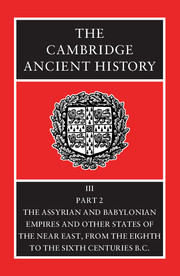Book contents
- Frontmatter
- Contents
- List of maps
- List of text-figures
- Preface
- PART I ASSYRIA AND BABYLONIA
- 21 Babylonia in the shadow of Assyria (747–626 B.C.)
- 22 Assyria: Tiglath-Pileser III to Sargon II (744–705 B.C.)
- 23 Assyria: Sennacherib and Esarhaddon (704–669 B.C.)
- 24 Assyria 668-635 B.C.: the reign of Ashurbanipal
- 25 The fall of Assyria (635–609 B.C.)
- 26 Assyrian civilization
- 27 Babylonia 605–539 B.C.
- 28 The culture of Babylonia
- 28a Neo-Babylonian society and economy
- 28b Babylonian mathematics, astrology, and astronomy
- 28c First-millennium Babylonian literature
- PART II THE EASTERN MEDITERRANEAN AND THE BLACK SEA
- Chronological Table
- Note on The Calendar
- BIBLIOGRAPHY
- Index
- Map 11: Phoenician and Punic sites in Spain
- Map 13: Scythia
- Map 14: Thrace
- References
28c - First-millennium Babylonian literature
from 28 - The culture of Babylonia
Published online by Cambridge University Press: 28 March 2008
- Frontmatter
- Contents
- List of maps
- List of text-figures
- Preface
- PART I ASSYRIA AND BABYLONIA
- 21 Babylonia in the shadow of Assyria (747–626 B.C.)
- 22 Assyria: Tiglath-Pileser III to Sargon II (744–705 B.C.)
- 23 Assyria: Sennacherib and Esarhaddon (704–669 B.C.)
- 24 Assyria 668-635 B.C.: the reign of Ashurbanipal
- 25 The fall of Assyria (635–609 B.C.)
- 26 Assyrian civilization
- 27 Babylonia 605–539 B.C.
- 28 The culture of Babylonia
- 28a Neo-Babylonian society and economy
- 28b Babylonian mathematics, astrology, and astronomy
- 28c First-millennium Babylonian literature
- PART II THE EASTERN MEDITERRANEAN AND THE BLACK SEA
- Chronological Table
- Note on The Calendar
- BIBLIOGRAPHY
- Index
- Map 11: Phoenician and Punic sites in Spain
- Map 13: Scythia
- Map 14: Thrace
- References
Summary
DEFINITION AND TRADITION
We do not know what literature was composed in first-millennium Babylonia; we know only what literary works were kept in royal and private libraries of that period. Some works may merely have found a repository there; others were very much in use, on religious occasions, to be recited or to serve as guides for ritual and magic performances. Still others were copied again and again, and the scholarly literature was extensively commented upon.
At the outset it has to be stated that the word ‘literature’ is here used in a broad sense, to include not only belles-lettres but also the standardized works of various experts – in divination, magic, ritual, and linguistic scholarship. That is to say, we will be considering that body of texts that has been termed by Oppenheim the ‘stream of tradition’.
The material to be considered is that kept at the royal library of Ashurbanipal at Nineveh, to which may be added such provincial libraries as Sultantepe, and, at the very end of the era of cuneiform writing altogether, the libraries of scholars in southern Babylonia, mostly from Uruk, dating to the Seleucid period, which to a large measure duplicate the texts from Nineveh and thus can serve to illustrate the literature of the period in question, 747–539B.C.
- Type
- Chapter
- Information
- The Cambridge Ancient History , pp. 293 - 321Publisher: Cambridge University PressPrint publication year: 1992

